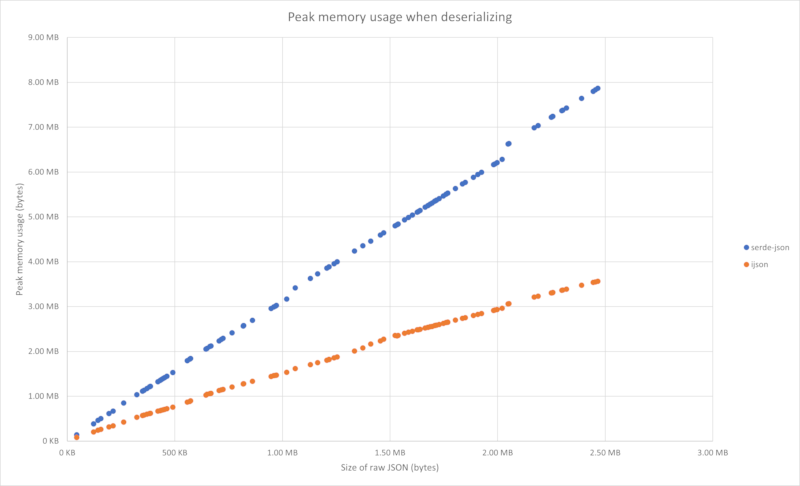4 releases
| 0.1.4 | Dec 3, 2024 |
|---|---|
| 0.1.3 | Sep 3, 2021 |
| 0.1.2 | Aug 24, 2021 |
| 0.1.1 | Apr 20, 2021 |
| 0.0.1 |
|
#123 in Encoding
178,747 downloads per month
Used in 10 crates
(7 directly)
550KB
5K
SLoC
ijson
This crate offers a replacement for serde-json's Value type, which is
significantly more memory efficient.
As a ballpark figure, it will typically use half as much memory as
serde-json when deserializing a value and the memory footprint of cloning
a value is more than 7x smaller.
Memory savings
These graphs show memory savings as a function of JSON size (in bytes). The
JSON is randomly generated using the template in the test_data folder
using the javascript dummyjson tool.




You can reproduce them yourself by installing dummy-json from NPM, and then
running these commands in the root directory:
cargo run --example generate --release
cargo run --example comparison --release > comparison.csv
The comparison.xlsx Excel file uses this CSV as a data-source to generate
the graphs.
Usage
IValue
The primary type exposed by this crate is the IValue type. It is guaranteed
to be pointer-sized and has a niche (so Option<IValue> is also guaranteed
to be pointer-sized).
Compared to serde_json::Value this type is a struct rather than an enum, as
this is necessary to achieve the important size reductions. This means that
you cannot directly match on an IValue to determine its type.
Instead, an IValue offers several ways to get at the inner type:
-
Destructuring using
IValue::destructure[{_ref,_mut}]()These methods return wrapper enums which you can directly match on, so these methods are the most direct replacement for matching on a
Value. -
Borrowing using
IValue::as_{array,object,string,number}[_mut]()These methods return an
Optionof the corresponding reference if the type matches the one expected. These methods exist for the variants which are notCopy. -
Converting using
IValue::into_{array,object,string,number}()These methods return a
Resultof the corresponding type (or the originalIValueif the type is not the one expected). These methods also exist for the variants which are notCopy. -
Getting using
IValue::to_{bool,{i,u,f}{32,64}}[_lossy]}()These methods return an
Optionof the corresponding type. These methods exist for types where the return value would beCopy.
You can also check the type of the inner value without specifically accessing it using one of these methods:
-
Checking using
IValue::is_{null,bool,number,string,array,object,true,false}()These methods exist for all types.
-
Getting the type with
IValue::type_()This method returns the
ValueTypeenum, which has a variant for each of the six JSON types.
INumber
The INumber type represents a JSON number. It is decoupled from any specific
representation, and internally uses several. There is no way to determine the
internal representation: instead the caller is expected to convert the number
using one of the fallible to_xxx functions and handle the cases where the
number does not convert to the desired type.
Special floating point values (eg. NaN, Infinity, etc.) cannot be stored within
an INumber.
Whilst INumber does not consider 2.0 and 2 to be different numbers (ie.
they will compare equal) it does allow you to distinguish them using the
method INumber::has_decimal_point(). That said, calling to_i32 on
2.0 will succeed with the value 2.
Currently INumber can store any number representable with an f64, i64 or
u64. It is expected that in the future it will be further expanded to store
integers and possibly decimals to arbitrary precision, but that is not currently
the case.
Any number representable with an i8 or a u8 can be stored in an INumber
without a heap allocation (so JSON byte arrays are relatively efficient).
Integers up to 24 bits can be stored with a 4-byte heap allocation.
IString
The IString type is an interned, immutable string, and is where this crate
gets its name.
Cloning an IString is cheap, and it can be easily converted from &str or
String types. Comparisons between IStrings is a simple pointer
comparison.
The memory backing an IString is reference counted, so that unlike many
string interning libraries, memory is not leaked as new strings are interned.
Interning uses DashSet, an implementation of a concurrent hash-set, allowing
many strings to be interned concurrently without becoming a bottleneck.
Given the nature of IString it is better to intern a string once and reuse
it, rather than continually convert from &str to IString.
IArray
The IArray type is similar to a Vec<IValue>. The primary difference is
that the length and capacity are stored inside the heap allocation, so that
the IArray itself can be a single pointer.
IObject
The IObject type is similar to a HashMap<IString, IValue>. As with the
IArray, the length and capacity are stored inside the heap allocation.
In addition, IObjects preserve the insertion order of their elements, in
case that is important in the original JSON.
Removing from an IObject will disrupt the insertion order.
Technical details
IValue
The six JSON types are broken down into those with a small fixed set of values:
- null
- bool
And those without:
- number
- string
- array
- object
Conveniently, this means we only need to distinguish between four different heap allocated types (those without) and this can be done using only 2 bits.
We make sure our heap allocations have an alignment of at least 4 (which is generally the case anyway) and this leaves us the two lower bits of a pointer to store a "tag" value.
As an added bonus, the alignment of 4 means there are 3 constant pointer
values (other than the null pointer) which can never be returned from
alloc:
- 0x1
- 0x2
- 0x3
These three pointer values map neatly onto the fixed values null, false
and true respectively. And with that, we've covered all the possible JSON
types!
All that's left is to find a way to store numbers, strings, arrays and objects behind a thin pointer.
INumber
It's not uncommon to store byte arrays in JSON. If we need to a heap allocation for every single byte in such an array it would be extremely inefficient. Also, some numbers are more common than others (0, 1, -1).
As a result, we need a way to encode numbers more efficiently the smaller they are, and ideally encode all possible byte values without a heap allocation. But we only have a single pointer to work with, and we've already used the tag bits!
The good news is that there just aren't that many byte values (256 to be exact) and even if we extend the range to signed bytes too, it's only 384. We can simply reserve a static array in our binary for these small integers.
In practice we use a nice round 512-entry array storing values from
-128 to 383 which more than covers the byte value range. When we
need to store one of these numbers we simply set our pointer to the
appropriate entry in the array, and skip any allocating or freeing.
IString
As mentioned previously, strings are interned. As well as saving a ton of memory when keys are repeated many times in arrays of objects, this also makes it trivial to store a string with a single pointer, we just set the pointer to the location of the interned string.
We also use a similar trick as for numbers to store the empty string more cheaply: we just declare a static variable to be the empty string, and use pointers to that.
IArray
This works just like a Vec, but we reserve extra space at the beginning
of the allocation to store the length and capacity.
We again use the static variable optimization so that the empty Vec does
not require an allocation.
IObject
Same idea as the IArray and the same static variable optimization.
Internally we actually store two arrays in the allocation: the first is
a simple array of IValues and the second is the hash-table itself.
The hash table just stored indices into the first array.
This simplifies the hash table implementation whilst also allowing us to preserve the insertion order and makes iteration very cheap (since we don't need to skip over empty entries).
New values are always pushed onto the end of the array before their
index is inserted into the hash table. Removed values are first swapped
to the end of the array (see Vec::swap_remove) so that removals are
still constant time.
The hash values are not stored, since the keys (IStrings) are interned
and so the hash function can be a very fast operation that only looks
at the pointer value.
Dependencies
~1.5–7MB
~43K SLoC